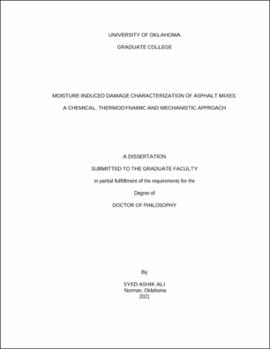| dc.description.abstract | Moisture-induced damage is one of the major distresses which leads to the deterioration of mechanical properties of asphalt mixes and failure of asphalt pavements. Evaluation of the moisture-induced damage potential is a challenging task because a number of factors including physical and chemical properties of aggregates and binders, aging, additives/polymers and other environmental and traffic conditions can significantly influence the adhesion and/or cohesion mechanisms of an asphalt mix. Previous studies have reported inadequacies of the current moisture-induced damage evaluation methods on their ability to address mechanisms that lead to failure of asphalt pavements. There is a need to identify relatively simple, reliable, and mechanistic methods for evaluating moisture-induced damage potential of asphalt mixes.
In this study, mechanistic approaches based on the thermodynamic theory, chemical characterization and laboratory-based performance tests were used to investigate the effects of different factors on the moisture-induced damage potential of asphalt mixes. Specifically, the thermodynamic theory using surface free energy (SFE) of constituent materials was used to mechanistically quantify the bonding strength of binder-aggregate systems. Attempts were made to study the effect of probe liquid sets and different SFE estimation methods on the calculation of moisture-induced damage of binder-aggregate systems. Suitable probe liquid sets to produce accurate and consistent energy parameters for binder-aggregate systems were identified. The changes in the bonding characteristics of an unmodified PG 64-22 and a polymer-modified PG 76-28 binders with the addition of different additives, namely warm mix asphalt (WMA) additive, anti-stripping agent (ASA), polyphosphoric acid (PPA) and reclaimed asphalt pavement (RAP) were determined using the SFE method. Also, the compatibility of these binders with commonly available aggregates under different aging conditions was investigated. Fourier transform infrared (FTIR) spectroscopy and X-ray fluorescence (XRF) tests were conducted on the binders to examine the effects of chemical compositions on the moisture-induced damage potential of asphalt mixes. The elemental compositions of aggregates were determined using the XRF results. Asphalt mixes containing different additives were produced in the laboratory for the evaluation of moisture-induced damage using Hamburg wheel tracking (HWT), indirect tensile strength (ITS) and two different semi-circular bend (SCB) tests, namely Louisiana SCB (LA-SCB) and Illinois SCB (IL-SCB) tests. Correlations between different laboratory-based moisture-induced damage parameters and the SFE parameters were investigated. The results of the SFE parameters and chemical analyses indicated that the properties of aggregates have significantly higher influence on the moisture-induced damage potential of a mix than the properties of binder. Also, asphalt mixes, in general, were found to become more prone to moisture-induced damage with in-service aging. The presence of amine group in both WMA and ASA was found to reduce the moisture susceptibility of asphalt mixes. However, the modification of binder with PPA is expected to increase the moisture-induced damage potential of a mix. Unconventional laboratory-based parameters from conventional tests, namely stripping number (LCSN) from HWT test and toughness index ratio (TI ratio) from ITS test exhibited potential to adequately characterize mixes for moisture-induced damage. Also, SCB test-based parameters, namely J-integral ratio (Jc ratio) from LA-SCB and fracture energy ratio (Gf ratio) from Illinois-SCB showed promises for use as alternate moisture-induced damage parameters for asphalt mixes. | en_US |
